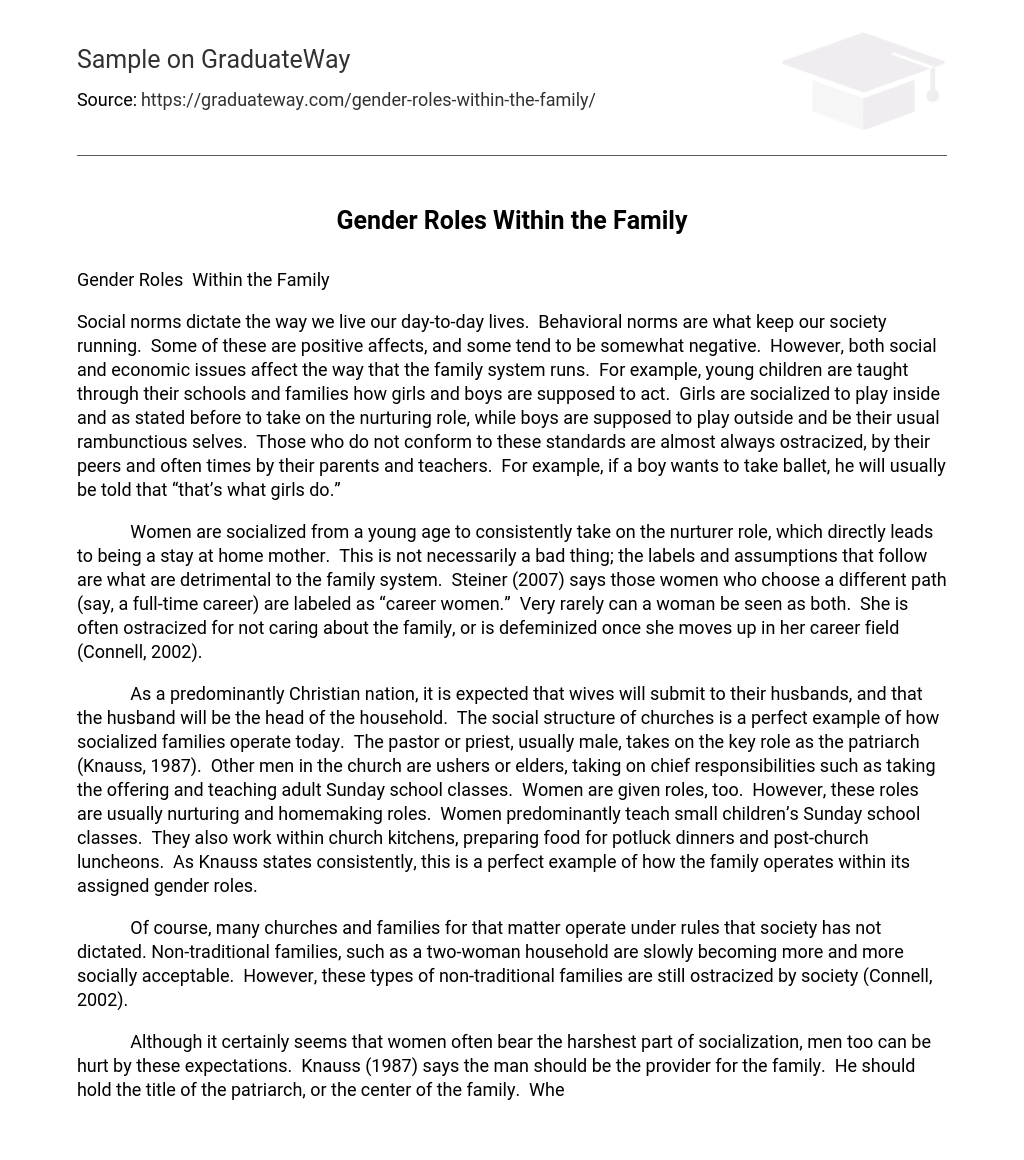Social norms dictate the way we live our day-to-day lives. Behavioral norms are what keep our society running. Some of these are positive affects, and some tend to be somewhat negative. However, both social and economic issues affect the way that the family system runs. For example, young children are taught through their schools and families how girls and boys are supposed to act. Girls are socialized to play inside and as stated before to take on the nurturing role, while boys are supposed to play outside and be their usual rambunctious selves. Those who do not conform to these standards are almost always ostracized, by their peers and often times by their parents and teachers. For example, if a boy wants to take ballet, he will usually be told that “that’s what girls do.”
Women are socialized from a young age to consistently take on the nurturer role, which directly leads to being a stay at home mother. This is not necessarily a bad thing; the labels and assumptions that follow are what are detrimental to the family system. Steiner (2007) says those women who choose a different path (say, a full-time career) are labeled as “career women.” Very rarely can a woman be seen as both. She is often ostracized for not caring about the family, or is defeminized once she moves up in her career field (Connell, 2002).
As a predominantly Christian nation, it is expected that wives will submit to their husbands, and that the husband will be the head of the household. The social structure of churches is a perfect example of how socialized families operate today. The pastor or priest, usually male, takes on the key role as the patriarch (Knauss, 1987). Other men in the church are ushers or elders, taking on chief responsibilities such as taking the offering and teaching adult Sunday school classes. Women are given roles, too. However, these roles are usually nurturing and homemaking roles. Women predominantly teach small children’s Sunday school classes. They also work within church kitchens, preparing food for potluck dinners and post-church luncheons. As Knauss states consistently, this is a perfect example of how the family operates within its assigned gender roles.
Of course, many churches and families for that matter operate under rules that society has not dictated. Non-traditional families, such as a two-woman household are slowly becoming more and more socially acceptable. However, these types of non-traditional families are still ostracized by society (Connell, 2002).
Although it certainly seems that women often bear the harshest part of socialization, men too can be hurt by these expectations. Knauss (1987) says the man should be the provider for the family. He should hold the title of the patriarch, or the center of the family. When this does not happen (the woman surpasses the man in income, the man becomes the stay at home parent,) the man is ostracized even by his family, sometimes being asked, “When are you going to get a real job?” Of course, it is politically incorrect to not consider a female homemaker’s job as a full-time, “real” job, but because of the socialization that men have endured through the years, it is not socially acceptable for the man to do anything except for be the chief provider and head of the household (Steiner, 2007).
It is easy to see how men and women both lose out when society determines the gender roles that they are supposed to play within the household. When the status quo is challenged, the family is seen as abnormal, even non-functioning (Connell, 2002). While some of these roles can be helpful, they are almost always a hindrance to reaching fully functioning familial potential.
References
Connell, R.w., and Raewyn Connell. Gender. New York: Polity P, 2002.
Knauss, Peter R. The Persistence of Patriarchy. 1st ed. Westport, CT: Greenwood Group, 1987.
Steiner, Leslie M. Mommy Wars: Stay At Home and Career Moms Face Off on Their Choices, Their Lives, Their Families. 1st ed. New York: Random House, 2007.





